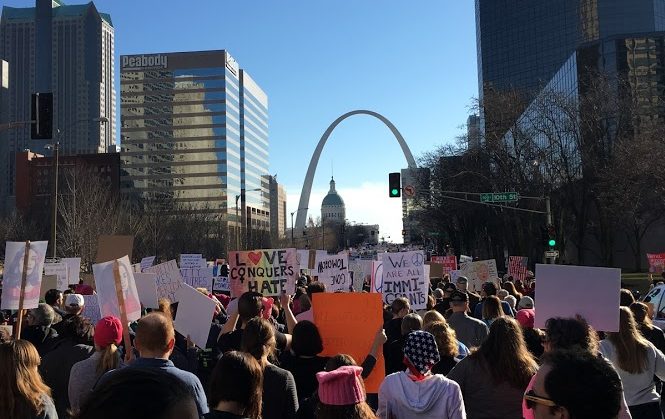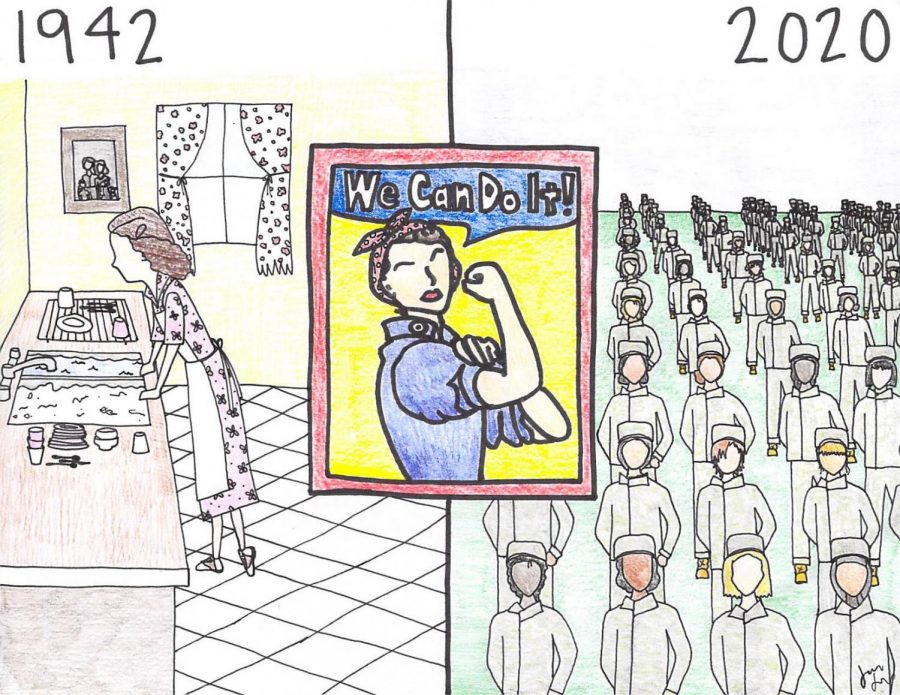Media by Marta Mieze
More than 10,000 people from Union Station on Market Street at the Women’s March on St. Louis march displaying signs with a variety of women empowerment sayings Jan. 21, 2017. The movement has taken place every year since placing emphasis on voter registration.
Women’s March & Feminism
Media by Marta Mieze
More than 10,000 people from Union Station on Market Street at the Women’s March on St. Louis march displaying signs with a variety of women empowerment sayings Jan. 21, 2017. The movement has taken place every year since placing emphasis on voter registration.
Once again, hundreds of thousands of ecstatic Women’s March attendees flooded the streets of Washington D.C. Jan. 18, showcasing pink cat hats and bold phrases on handmade signs.
Once again, protesters tried to display utmost support for women’s critical issues as well as immigration, impeachment and the environment to increase voter participation.
This supposedly “now more diverse” protest spread awareness of an underlying issue: the Women’s March represents the social divisions of feminism and the concepts of “separate but equal” concerning women of color, especially for black women and other marginalized groups.
Specific to the march, the injustices began when the original title “Million Women March,” mirroring the 1997 protest for family unity and black female awareness, was replaced. Then its initial goals of vast representation were deserted to accommodate the influx of supporters and the anti-Trump agenda in 2017.
This year, Black Lives Matter: Los Angeles wasn’t invited to the fourth annual demonstration for the first time. The Women’s March Foundation provided a statement saying this is an “important” election year, therefore, they will only highlight those “who have a mission to register and encourage people to vote.”
Traditional feminism only spares time for coverage of minorities’ inconvenient issues when the opportunity for significant change and awareness will pass, or if it alludes to ideals of white, middle class women to take advantage of.
As a black female, I cannot choose between my womanhood and my blackness for representation in today’s feminist ideas. Black women are still the most disrespected, marginalized and unsupported women in all aspects of society.
Specifically, black women are reduced to organizing separate demonstrations to advocate for our safety, rights and concerns such as systematic oppression, high rates of violent, sexual, and missing persons crime cases and disproportionately low academic achievement.
Not all women may ever be represented in a women’s march because of diversity and lack of emphasis on minorities’ histories of discrimination and struggle in educational systems.
However, there are too many complexities within feminism to think there is a one size fits all compromise to solve systematically ignored political conflicts.
Marginalized and transgender women’s issues are women’s issues too. They should be issues important to voters and to the fight against inequality because they are most targeted by democratic candidates.
Even though I preach strength in numbers and support protests, I cannot encourage my black sisters to waste their support for the Women’s March next year until the march begins to meet a higher standard of inclusivity and diversity.
Women of every color and creed can be triumphant together, but first we must understand the importance and strength of our shared values and interests to be true changemakers.
To eventually support all women, feminist movements like the Women’s March need to repair their reputation and address their prejudice and transphobia by creating alliances with minority and transgender advocacies, and allowing them to hold meaningful leadership positions.
Equal Rights, Equal Fights
Media by Jilian Bunderson
In a 2016 survey conducted by Rasmussen Reports, 61 percent of male voters are in favor of women being included in the draft, while only 38 percent of women also agree.
Starting off the new year with tweets circling raging of World War III certainly was a disturbance to American citizens.
Though many of the younger people have put it upon themselves to make light humor out of the very real situation, it brings up questions on the main punch line of the joke: the draft.
During World War ll, the Selective Service Act was set in place so men of the ages 18-25 must register for Selective Service in case of a national emergency. Among the lingering questions involving the draft there is one on whether women should be required for Selective Service as well.
The idea of women in the draft is typically a controversial topic between men and women, and as of 2020, women are still not obligated to sign up for Selective Service. Some argue Selective Service strictly aimed toward men is unconstitutional and not including women in the draft does nothing for the fight for equality between men and women.
A common rebuttal against feminists urging equality is a question: “If women want equality, then why don’t they ask to get drafted?” On the spot, a defensive girl might protest and insist that of course women believe in being drafted, but the truth says otherwise.
In a 2016 survey conducted by Rasmussen Reports, 61 percent of male voters are in favor of women being included in the draft, while only 38 percent of women also agree. 52 percent of women disagree with incorporating women into the draft, while the remaining 10 percent are undecided.
To pursue equality only when it is most convenient is not how feminism, nor any form of equal justice, should be portrayed. If women in America want to have the same opportunities as men, as they should, then women should also be prepared for the same obligations. Both men and women should be seen in the same light in their ability to defend their country in a time of need.
Six in 10 women in America identify as feminists, according to a poll conducted by the Washington Post and Kaiser Family Foundation.
And with the World War III memes flooding in, many are from female creators who are expressing their gratitude for not being included in the draft, posing as old-fashioned housewives. While it is all good fun, is it truly how women feel about being drafted?
In order for us as a society to progress, it is a necessity for equality to be spread throughout all occasions, be it in the military, workplace, or educational system, not just when it is fitting.
Starting off the new year with tweets circling raging of World War III certainly was a disturbance to American citizens.
Though many of the younger people have put it upon themselves to make light humor out of the very real situation, it brings up questions on the main punch line of the joke: the draft.
During World War ll, the Selective Service Act was set in place so men of the ages 18-25 must register for Selective Service in case of a national emergency. Among the lingering questions involving the draft there is one on whether women should be required for Selective Service as well.
The idea of women in the draft is typically a controversial topic between men and women, and as of 2020, women are still not obligated to sign up for Selective Service. Some argue Selective Service strictly aimed toward men is unconstitutional and not including women in the draft does nothing for the fight for equality between men and women.
A common rebuttal against feminists urging equality is a question: “If women want equality, then why don’t they ask to get drafted?” On the spot, a defensive girl might protest and insist that of course women believe in being drafted, but the truth says otherwise.
In a 2016 survey conducted by Rasmussen Reports, 61 percent of male voters are in favor of women being included in the draft, while only 38 percent of women also agree. 52 percent of women disagree with incorporating women into the draft, while the remaining 10 percent are undecided.
To pursue equality only when it is most convenient is not how feminism, nor any form of equal justice, should be portrayed. If women in America want to have the same opportunities as men, as they should, then women should also be prepared for the same obligations. Both men and women should be seen in the same light in their ability to defend their country in a time of need.
Six in 10 women in America identify as feminists, according to a poll conducted by the Washington Post and Kaiser Family Foundation.
And with the World War III memes flooding in, many are from female creators who are expressing their gratitude for not being included in the draft, posing as old-fashioned housewives. While it is all good fun, is it truly how women feel about being drafted?
In order for us as a society to progress, it is a necessity for equality to be spread throughout all occasions, be it in the military, workplace, or educational system, not just when it is fitting.


